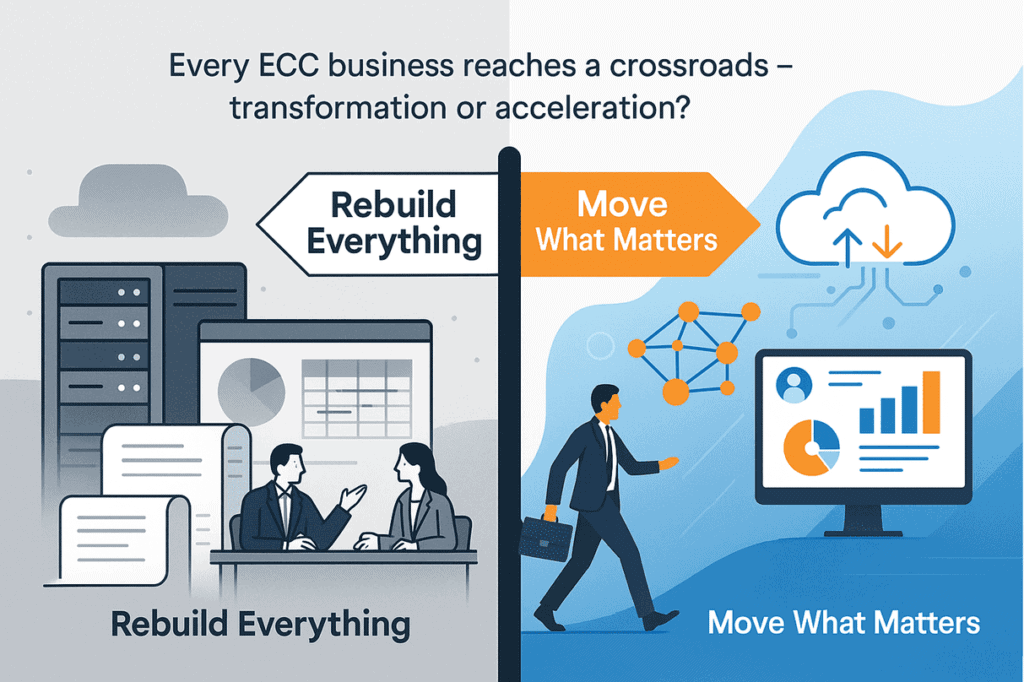
Every organization on ECC eventually faces the same decision, rebuild everything or move what truly matters. For some, S/4HANA is a chance to transform from the ground up, redesigning processes and landscapes. For others, it’s about taking a practical route — migrating quickly, minimizing disruption, and staying focused on business continuity. Both paths have merit. One promises reinvention but demands time, money, and patience. The other gets you there faster but may miss out on what S/4HANA can truly offer.
At Absoft( an Applexus company), we’ve seen both worlds. Large enterprises thrive on full-scale transformation. But for many mid-market organizations, what they really need is balance — a smarter, cleaner way to migrate without losing what works. That’s exactly where MVP+ finds its purpose. It is the middle ground that brings focus, speed, and value to the S/4HANA journey.
The Traditional Migration to S/4HANA
For many businesses, moving to S/4HANA is a chance to rebuild everything, modernize processes, and design a clean future state. Teams spend months mapping every transaction, identifying dependencies, reviewing years of customizations, and deciding which business processes stay and which go.
Here’s what a typical traditional implementation involves:
- Extensive upfront assessment: Detailed discovery of existing processes, system usage, and customizations before defining the target architecture.
- Rebuild and reconfigure: Core modules and integrations are rebuilt to align with new environments — often replicating parts of the legacy design.
- Long, phased testing cycles: Validation happens in iterative phases, ensuring that every dependency is accounted for before cutover.
- Parallel operations: Old and new systems often run simultaneously for extended periods, allowing gradual stabilization.
- Comprehensive change management: With larger timeframes and bigger teams, organizational alignment becomes a continuous effort.
The MVP+ Migration to S/4HANA
Where the traditional route builds the entire bridge before crossing it, the MVP+ approach starts walking — one step at a time, learning, adjusting, and evolving along the way. The MVP+ model brings agility to what was once an all-or-nothing journey. It’s not about doing less, it’s about doing smarter. You begin with a focused scope. The core capabilities that deliver tangible business value first. Then, you expand, refine, and build upon real user feedback.
Here’s what a typical MVP+ S/4HANA migration involves:

- Targeted discovery: AI scans ECC to identify active processes, key customizations, integrations, and high-value critical data.
- Selective planning and design: Only essential processes are migrated, custom code remediated, and integrations streamlined for security and efficiency.
- Core system build: The S/4HANA environment is constructed with critical processes activated first, security roles implemented from day one, and legacy clutter left behind.
- Accelerated validation: Automated testing confirms functional accuracy, integration reliability, and system performance before go-live.
- Smooth go-live and support: Minimal downtime cutover with monitoring and support ensures immediate operational benefits for business continuity.
A Side-by-Side Look at Traditional vs. MVP+ Migration
Aspect | Traditional Implementation | MVP+ Migration |
|---|---|---|
Scope | Full-scale rebuild of processes, systems, and configurations | Focused migration of what’s critical to business operations |
Timeline | 12–24 months (or more) | 4–8 months on average |
Cost | High – extensive design, development, and testing | Optimized – smaller scope, fewer dependencies |
Business Disruption | Significant – requires full-time involvement from business teams | Minimal – lean engagement with focused workshops |
Risk | High – longer timeline means higher chance of delays and overruns | Low – smaller, iterative, and controlled scope |
Outcome | Complete transformation, but high complexity | Clean-core system that reflects your current reality and scales with you |
Choosing the Right Path: Traditional vs MVP+
Every business has different priorities, resources, and timelines. Choosing between a full-scale transformation and a focused MVP+ migration isn’t about right or wrong, it’s about fit. Here’s a guide to help mid-market organizations understand which path aligns with their needs:
- When a Traditional S/4HANA migration makes sense
If you’re looking to redesign processes, consolidate systems, or reimagine operations from the ground up, a traditional approach could be right. It suits companies with bigger budgets, larger internal teams, and the bandwidth to commit to workshops, iterative testing, and phased cutovers. You get full customization, process reinvention, and a system built for the long term — but it comes with higher costs, longer timelines, and more disruption.
- When MVP+ migration is the smarter move
MVP+ is best for mid-market businesses focused on operational continuity, cost efficiency, and speed-to-value. It is designed for companies that want to migrate critical processes quickly, preserve functional stability, reduce risk, and leverage built-in S/4HANA capabilities without unnecessary complexity. It’s practical, cost-effective, predictable, and delivers immediate operational benefits.
Key Things To Consider Before Deciding Your Migration Path
Timeline urgency
How quickly does your business need to be live on S/4HANA?

Budget flexibility
Are multi-year, multi-million projects feasible?
Business complexity
Do processes require full redesign, or are current operations efficient?

Risk tolerance
Can the business absorb potential delays, disruptions, or scope creep?
Navigating S/4HANA Migration with Applexus
Deciding how to move to S/4HANA comes down to understanding your business and what it needs right now. You want a system that supports your operations, reduces risk, and lets your teams keep running without being bogged down in long projects. That’s where experience matters. At Applexus, we’ve guided mid-market companies through both traditional and MVP+ migrations, helping them weigh options, plan with clarity, and take action.
With our tools and approach, you get a system that reflects your priorities, runs efficiently from day one, and leaves room to grow. We’ve seen what works, what stalls projects, and how to make the migration process predictable. By understanding your priorities across these factors, you can choose the migration approach that balances speed, cost, and business impact. There’s no one-size-fits-all answer, but clarity on your goals ensures the path you take matches your reality.









